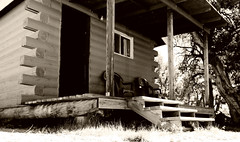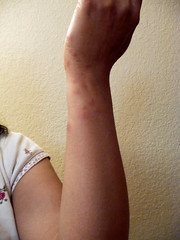Don't Let the Bed Bugs bite
Thursday, July 24, 2008
Posted by Indian Food Rocks
Good night! Are you interested in contributing to The Daily Tiffin? Drop us an email: thedailytiffin@gmail.com. We look forward to hearing your ideas. This Post was written by Manisha of Indian Food Rocks
Sleep tight!
Don't let the bed bugs bite!
How many times have you said that without really thinking about it? Or heard it said to you? Do you know what a bed bug is? Do you know what a bed bug bite feels like? Do you know what it means for you?
I do.
And once you have been through what I went through, you won't find that bedtime rhyme cute anymore.
My next article was supposed to focus on pure strategy board games but I had to take an unscheduled digression to discuss this awful epidemic that is spreading across the travel and tourism industry and in urban housing complexes across the United States.
Yes, bed bugs.
Bed bugs were as good as eliminated by the 1970s through indiscriminate use of the pesticide known as DDT. As the world became smaller and international travel cheaper, the rest of the temperate world took its revenge on the United States for sharing the roach with them - according to me, that is - and gave the bed bug in return. Changes in pest control practices such as the banning of DDT have possibly also contributed to the problem. But I like the first reason more!Adult bedbugs are a reddish brown, flattened, oval, and wingless, with microscopic hairs that give them a banded appearance. A common misconception is that they are not visible to the naked eye. Adults grow to 4 to 5 mm (one-eighth to three-sixteenths of an inch) in length and do not move quickly enough to escape the notice of an attentive observer. Newly hatched nymphs are translucent, lighter in color and continue to become browner and moult as they reach maturity. When it comes to size, they are often compared to lentils or appleseeds.
Bed bugs are nocturnal, becoming active just before dawn. They are wingless and therefore do not fly. They scamper quickly over floors, walls, and even ceilings. They are known to jump from one surface to another below it, like for instance from the bunk bed on the top to the one below it. Their tiny flattened bodies make it possible for them to hide in crevices and cracks. They hide near the seams of mattresses and box springs, in cracks on the wooden trims along a floor, underneath the edge of carpets, and even under nightstands.
They are attracted by the warmth of our bodies and by the carbon dioxide that we breathe out. Typically, they feed once every 3-5 days. They have two 'tubes or 'beaks'; they use one to anesthetize the area they will feed on and they use the other to suck the blood of ...well, you and me. They can live as long as 18 months without feeding and the lifespan of a well-fed bed bug is, on an average, 8-9 months.The female bedbug can lay up to five eggs a day, and several hundred over its lifetime. At room temperature, the sticky clumps of eggs hatch in 7 to 14 days into tiny nymphs no bigger than a speck of dust. The nymphs go through five life stages, taking a blood meal each time, before molting one last time into adulthood.
There is no pesticide that you or I can buy in the market that can kill bed bugs although they say pyrethroids, if properly used, can do the job. In the event of an infestation, they can only be commercially removed. Interestingly enough, dogs can smell bed bugs and are used by pest control companies and exterminators to sniff for bed bugs!
We almost called in the exterminators ourselves. You see, we had camped in the cutest log cabin in Mesa Verde, Colorado on our summer vacation and we loved it so much that we stayed an extra day. I was being bitten from the first night itself but I brushed it off as mosquito bites. It only got worse the next night by which time I was sure it was something in the wood. The third night was sheer torture. Next, we camped out in the open in the Sand Dunes and my bites worsened. Yes, we had carried them with us in our sleeping bags. Bed bugs bites are usually linear and in groups of three bites: breakfast, lunch and dinner.
When we returned home, I had bites on my scalp, my face, my neck, my belly, my back, my arms and my legs. Everywhere. The itch was sheer torture. It is good to know that bed bugs are not carriers of any disease but if you scratch the bites and draw blood, the open wounds could get infected. Our body releases histamines in response to insect bites and there is often an allergic reaction to the bites that looks very much like a bite itself! It's a good idea to start on over-the-counter anti-histamines or get a prescription as soon as possible. Cold compress or ice wrapped in soft cotton is the best topical antidote. Mild steroidal hydrocortisone also helps reduce the itch but remember that I am not a doctor, so always seek advice from a professional in these matters.
I washed every single thing that could be washed, in very hot water. That which could not be washed was bundled up and loaded back into the van. Luckily for us, it was the dog days in Colorado. A heat wave and for once, I was really very happy about it. The van stood in the sun and if there were any bed bugs, they were cooked as temperatures inside the van soared to 110F-120F. Yes, cook them! And then vacuum, vacuum, vacuum your house and then do it all over again, especially the crevices, cracks and areas that could potentially serve as good hiding places.
Sleeping at night became a pipe dream, a thing of the past. We were not being bitten anymore but we started imagining that we were. Yes, serious mental anguish and paranoia ensued! We read that if you think you are being bitten, then it is best not to turn on the lights as the bed bugs will simply move back to their hiding places very quickly. Instead, keep a flashlight by your side and use that to look for them. We had flashing lights in our bedroom for many many sleepless nights.
So what does kill them? I guess there are commercial pesticides that can be used only after evacuating the home. There is one more thing that is said to work: diatomeceous earth (DE). It is finely ground shells that feels almost like talcum powder to us but has jagged edges for those monsters bugs. If the bugs walk across a sprinkling of DE, their outer waxy coating is sliced or cut in places, leading to dehydration and death over a period of 4-5 days. DE could take up to 10 days to work. But it is organic and does not contain pesticides.
We found DE at the local hardware store and nursery and sprinkled it liberally all over the house, including our mattresses. In the van, too. After a few more days of paranoia, we were able to finally get some rest at night again and focus on our work and lives during the day.
Bed bugs are the worst nightmare anyone could have. And you literally sleep through their bites. Some precautions you could take when you travel include:
- removing all bedding from the mattress and inspecting the mattress for dark tell-tale stains of their feces. You should look for molted skin, eggs, eggshells, dead bugs and live bugs, too. If you see anything like this, ask for another room immediately. The hotel industry is currently in denial and will strongly refute the existence of bugs on their property.
- do not place your bags on the beds. Instead use the luggage racks and move them away from the walls.
- do not keep your clothes on the beds. Put them up on hangers instead.
- keep your bags closed at all times so that bed bugs do not crawl into them and hitch a ride home.
Other precautions include:
- avoid picking up mattresses left on the curbside
- if you buy anything secondhand - even a desk - inspect it for tell-tale signs of bed bugs
I know most of you will be grossed out by this information and my story. If it makes you more aware of the problem, I think it is well worth the nausea that you might be experiencing just now.








Manisha - I thought after chatting with you a few days ago got me itching everywhere - but this is making me freak! Your ordeal with these monsters was incredible but a fight you guys won in the end.
A few years ago we were in Italy and Tom came back home with bites everywhere too - at first we thought they were mosquito bites but in actual fact they were sand lice!! That was nothing compared to what you have described here though.
While the post still makes me itch, I think it comes at a good time to make people aware and take the required precautions.